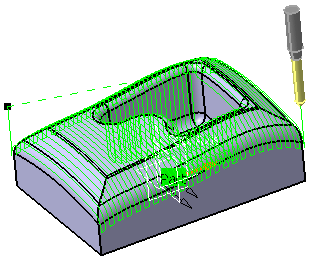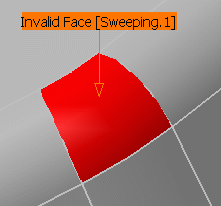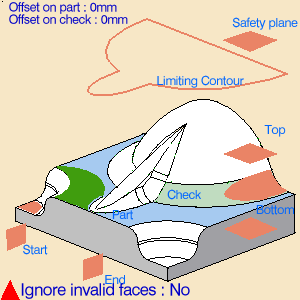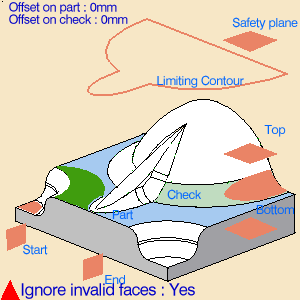Sweeping is a semi-finishing and finishing operation that is used after a part has been rough machine
and that machines the whole part. The tool paths are executed in vertical parallel planes.
To create the operation you define:
- the
geometry of the part to machine
 ,
,
- the
tool to use
 ; you have the
choice of end mill
; you have the
choice of end mill  or
conical
or
conical  tools for
this operation,
tools for
this operation,
- the parameters of the
machining
strategy
 ,
, - the feedrates and spindle speeds
 ,
, - the macros
 .
.
Only the geometry is obligatory, all of the other requirements have a default value.
- make the Manufacturing Program current in the specification
tree if you want to define an operation
and the part/area to machine at the same time, - or select a machining feature from the
list if you have already defined the area to machine and
now you want to define the operation to apply to it.
Below we are going to see how to do the first of these.
Open file Basic1.CATPart then select Machining > Surface Machining in the Start menu.
-
Click Sweeping
 .
.
A Sweeping entity and a default tool are added to the program.
The dialog box opens at the geometry tab page .
.
This page includes a sensitive icon to help you specify the geometry to be machined.
The area that represents the part geometry is colored red indicating that the geometry is required
for defining the area to machine. -
Click the red area in the sensitive icon and select the part in the viewer.
Then double-click anywhere in the viewer to confirm your selection and redisplay the dialog box. -
In the Radial tab, change the Maxi. distance between pass to 5mm.
-
Click Tool Path Replay
 .
.
A progress indicator is displayed. You can cancel the tool path computation at any moment before 100% completion.
You will see that the top surface and the bottom of the pocket have been sweep machined.

Invalid Face
-
If a tool path cannot be computed because of invalid faces,
an explicit warning message like this one will appear:

Each invalid face is highlighted in red, with an arrow pointing on it.

This visualization is removed when you close the main dialog box or
when you select Remove in the contextual menu.

-
Click OK in the Warning box to revert to the main dialog box.
In the Geometry tab, a message Ignore invalid faces: No is displayed:

-
You can either:
- close the dialog box.
When you reopen it, the Ignore invalid faces: No will not be displayed. - heal the defective geometry and restart the computation.
If it is successful the message Ignore invalid faces: No will disappear. - ignore the invalid faces. Click the text Ignore invalid
faces: No.
It will turn to Ignore invalid faces: Yes and the computation will continue.
The message remains displayed as a warning.

- close the dialog box.
We recommend that you ignore only faces that will not affect the tool path.
Otherwise this may lead to defective tool paths.